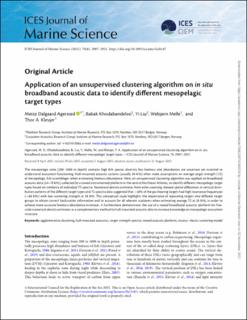| dc.contributor.author | Agersted, Mette Dalgaard | |
| dc.contributor.author | Khodabandeloo, Babak | |
| dc.contributor.author | Liu, Yi | |
| dc.contributor.author | Melle, Webjørn Raunsgård | |
| dc.contributor.author | Klevjer, Thor Aleksander | |
| dc.date.accessioned | 2021-11-04T10:32:45Z | |
| dc.date.available | 2021-11-04T10:32:45Z | |
| dc.date.created | 2021-09-16T11:33:48Z | |
| dc.date.issued | 2021 | |
| dc.identifier.citation | ICES Journal of Marine Science. 2021, 78 (8), 2907-2921. | en_US |
| dc.identifier.issn | 1054-3139 | |
| dc.identifier.uri | https://hdl.handle.net/11250/2827817 | |
| dc.description.abstract | The mesopelagic zone (200–1000 m depth) contains high fish species diversity but biomass and abundances are uncertain yet essential to understand ecosystem functioning. Hull-mounted acoustic systems (usually 38 kHz) often make assumptions on average target strength (TS) of mesopelagic fish assemblages when estimating biomass/abundance. Here, an unsupervised clustering algorithm was applied on broadband acoustic data (54–78 kHz), collected by a towed instrumented platform in the central Northeast Atlantic, to identify different mesopelagic target types based on similarity of individual TS spectra. Numerical density estimates from echo-counting showed spatial differences in vertical distribution patterns of the different target types and TS spectra data suggested that >30% of the gas-bearing targets had high resonance frequencies (>60 kHz) with low scattering strength at 38 kHz. This conceptual study highlights the importance of separating targets into different target groups to obtain correct backscatter information and to account for all relevant scatterers when estimating average TS at 38 kHz, in order to achieve more accurate biomass/abundance estimates. It furthermore demonstrates the use of a towed broadband acoustic platform for fine-scale numerical density estimates as a complementary method to hull-mounted acoustic data to increase knowledge on mesopelagic ecosystem structure. | en_US |
| dc.language.iso | eng | en_US |
| dc.title | Application of an unsupervised clustering algorithm on in situ broadband acoustic data to identify different mesopelagic target types | en_US |
| dc.type | Peer reviewed | en_US |
| dc.type | Journal article | en_US |
| dc.description.version | publishedVersion | en_US |
| dc.source.pagenumber | 2907-2921 | en_US |
| dc.source.volume | 78 | en_US |
| dc.source.journal | ICES Journal of Marine Science | en_US |
| dc.source.issue | 8 | en_US |
| dc.identifier.doi | 10.1093/icesjms/fsab167 | |
| dc.identifier.cristin | 1934839 | |
| dc.relation.project | Norges forskningsråd: 280 546 | en_US |
| dc.relation.project | EC/H2020/817669 | en_US |
| cristin.ispublished | true | |
| cristin.fulltext | original | |
| cristin.qualitycode | 1 | |
